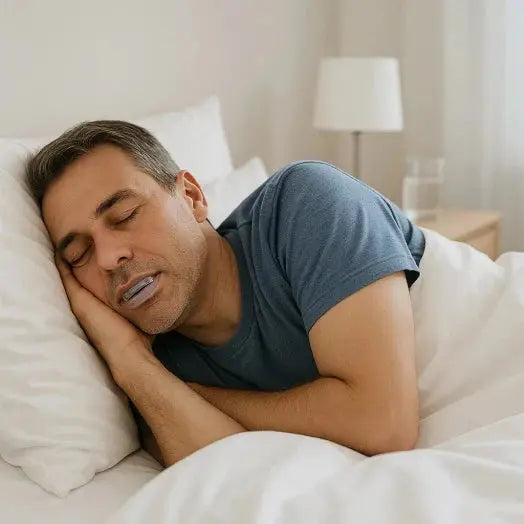
Many people who struggle to use a continuous positive airway pressure (CPAP) machine turn to using a mandibular advancement device (MAD).
A MAD is a small, custom-made mouthpiece that looks like a sports mouthguard. Its job is simple: it gently moves your lower jaw and tongue forward to help keep your airway open while you sleep. For many, it’s a helpful substitute for CPAP therapy.
The Mouth Breathing Problem
Here’s the catch: while a MAD can improve airflow, it can also lead to mouth breathing during sleep. Why? Because the device holds your jaw forward, making it harder for your lips to stay closed. This often results in:
- Increased mouth breathing
- Dry mouth and throat
- The tongue falling back, encroaching on the airway.
- More airway collapse
- Poorer sleep quality
- Worsening of apnea symptoms
The Buteyko Method: A Proven Approach to Better Breathing
Fortunately, there are safe, effective ways to improve your breathing and boost the benefits of your MAD.
Nasal Breathing
Breathing through your nose supports ideal tongue and jaw position, keeps your airway more stable, reduces resistance, and supports better oxygen intake.
Tools like MyoTape gently encourage you to breathe through your nose at night, without sealing your lips shut, making it safe for use with a MAD or CPAP machine.
Breathing Re-Education
The Buteyko Method exercises in The Breathing Cure for Better Sleep train you to breathe lightly, slowly, deeply, and nasally. This helps:
- Maintain nasal breathing day and night
- Reduce airway pressure
- Ease breathing effort
- Calm the nervous system
- Support better sleep
Myofunctional Therapy
This involves simple, targeted exercises to strengthen your tongue, lips, and throat. Stronger muscles mean:
- Less airway collapse
- Less snoring
- Better breathing—whether you’re using a MAD, CPAP, or neither
🔗 Want to work with a Myofunctional Therapist trained in the Buteyko Method? [Click here to find a specialist who can help.]
Mouth Taping: Helpful or Harmful?
You may have noticed mouth taping trending on social media, and for good reason. Nasal breathing during sleep can improve oxygen levels, reduce snoring, and support deeper sleep.
But here’s what many people don’t realize: traditional mouth tape seals the lips completely, which can be risky if you have sleep apnea or experience mouth puffing—an involuntary reflex to release air when nasal breathing isn’t enough.
In fact, research has shown that sealing the mouth can worsen symptoms in people with more severe OSA.[1]
Why MyoTape Is a Safer Choice
MyoTape was created for comfort, safety, and better sleep. Unlike traditional tape, MyoTape:
- Wraps gently around the lips
- Encourages mouth closure without blocking oral airflow
- Allows for natural mouth puffing if needed
This makes it ideal for use with a MAD, CPAP machine, or both. It helps maintain consistent nasal breathing throughout the night, improving sleep quality and overall comfort.
New to MyoTape? Start by wearing it for 20 minutes before bed, or while walking or watching TV. This helps you get used to it and builds the habit of nasal breathing.
🔗Click here to purchase MyoTape. Use code Myo10 for 10% off
🔗Check out our Guide to Mouth Taping: Do’s, Don’ts, and Benefits for Sleep and Breathing
Bottom Line
Whether you're using a MAD, a CPAP machine, or exploring other options, nasal breathing is key to better sleep. Support it with the right tools, science-backed breathing techniques, and professional guidance when needed.
When your breathing is light, calm, and through your nose, you sleep deeper, feel better, and wake up truly refreshed.
Want to learn more? [Discover The Breathing Cure for Better Sleep by Patrick McKeown →]
References:
[1] Jau, J. Y., Kuo, T. B. J., Li, L. P. H., Chen, T. Y., Hsu, Y. S., Lai, C. T., Yue, W. C., Huang, P. H., & Yang, C. C. H. (2023). Mouth Puffing Phenomenon and Upper Airway Features May Be Used to Predict the Severity of Obstructive Sleep Apnea. Nature and science of sleep, 15, 165–174.
